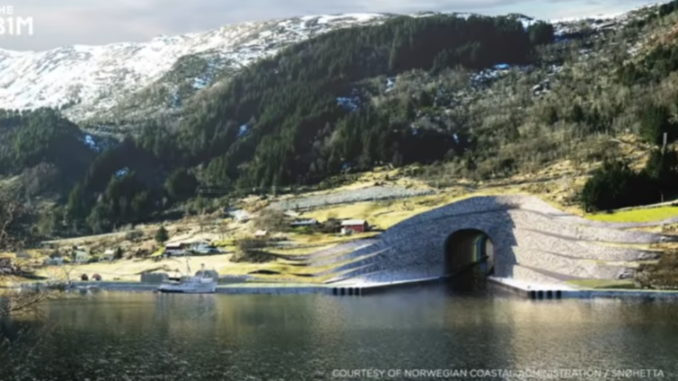
In southwest Norway, the seacoast parallels nearly perfectly with an imaginary north-south longitudinal line. At the Stad Peninsula, the coastline abruptly changes direction towards the northeast. The waters off this rocky point are called the Stadhavet Sea, well known to mariners as the most dangerous part of the Norwegian coast, with treacherous storms, high winds, enormous waves, and unpredictable currents much of the year. Even in good weather, the trip through these waters is challenging for vessels of all sizes, including large ships. The national economy is dependent on coastal shipping for fishing, tourism, and the transportation of people and goods between cities.
The Stadhavet Sea has been a dangerous gauntlet to ships for at least a millenium. Vikings would drag their longships over land to avoid the stormy waters. Norwegians have talked about building a canal or tunnel through the narrow neck of the Stad Peninsula for more than a century that would allow coastal sea traffic to detour around the rough waters by following fjords inland. Now, they have a plan and a budget to do it. The Stad Ship Tunnel project has been funded to the tune of $315 million U.S. dollars and will commence construction in 2022. Completion is targeted for 2025 or 2026.
The tunnel, as designed, will be 1,700 meters (one mile) long, 37 meters (121 feet) high, and 26.5 meters (87 feet) wide. The water in the tunnel will be 12 meters (39 feet) deep, although the depths of the fjords on either side of the underground canal are much greater. Vessels of up to 16,000 tons will be accomodated, which is large enough for all but the biggest cruise ships and freighters. Authorities estimate five ships per hour could traverse the tunnel. That’s one ship every twelve minutes.
I wanted to embed a high quality video created by an organization called “The B1M” but, alas, they frown on embedding their videos in third-party websites without prior permission. However they do encourage linking to their stories and videos as long as they are given proper credit. So, here goes: The B1M made the following high quality video, and here is the link: “Norway’s Cruise Ship Tunnel Plan Explained” (5:34). [Opens in a new window.]
By the way, several articles and videos refer to the Stad Ship Tunnel as the world’s first ship tunnel. That statement is only accurate if the word ‘ship’ is defined as a vessel too large to fit through any of the waterway tunnels that have been dug previously. Most of those were built to protect submarines, patrol boats, landing craft, and other warships from bombing raids, although there have been some tunnels built on waterways for civilian vessels to navigate.
Question Of The Night: Have you been to Scandanavia? Would you visit again? If you’ve never been, would you like to visit?
